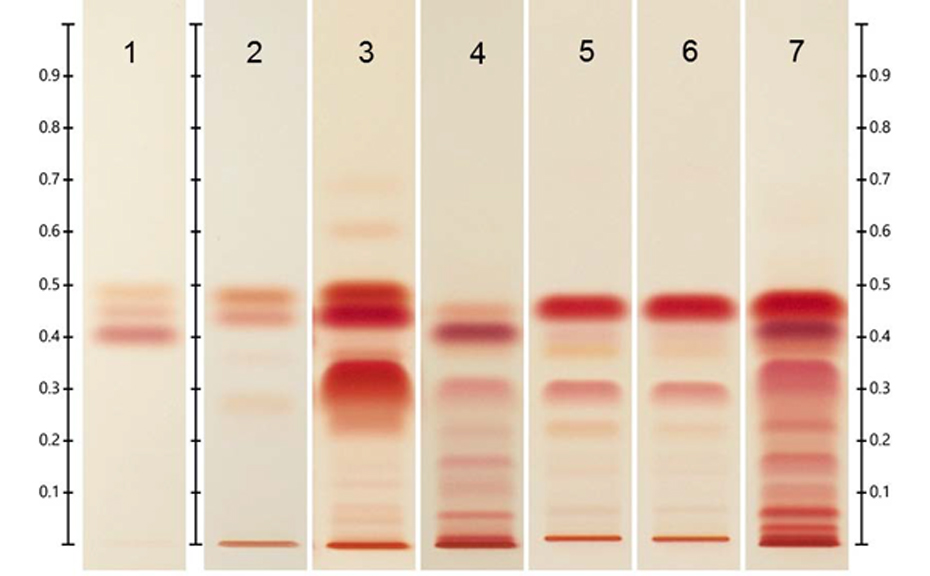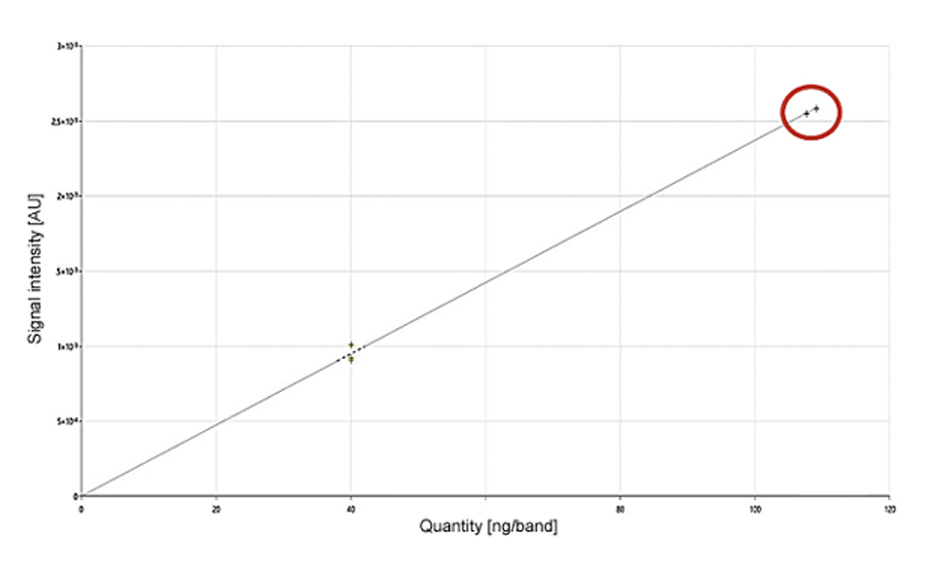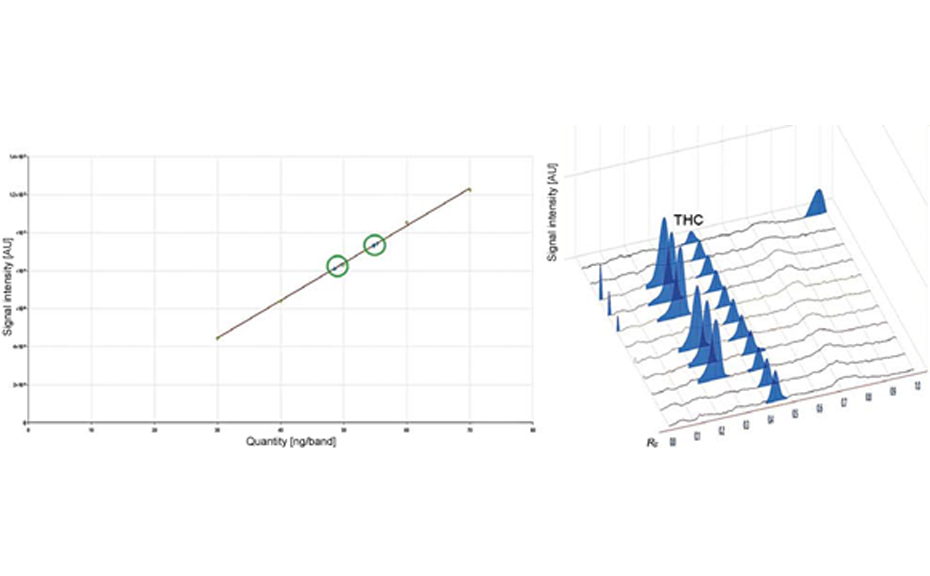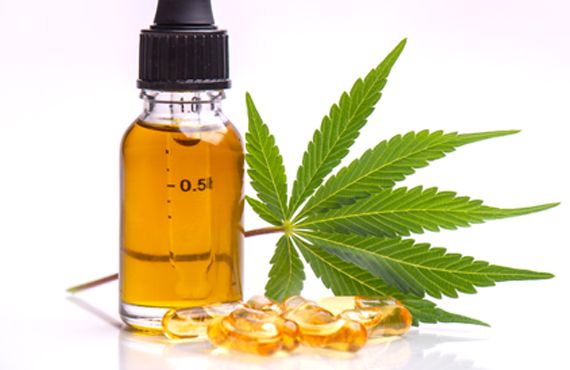Quantification of tetrahydrocannabinol in Cannabis sativa
Introduction
Cannabis sativa, the hemp plant, is one of the oldest crops of mankind and an important resource for the production of textile fibers, food products and medical drugs. Cannabinoids are the substances of medical interest in Cannabis, such as the analgesic cannabidiol (CBD). The cannabinoid tetrahydrocannabinol (THC), however, has an intoxicating effect, for which Cannabis is used as a narcotic drug. In the USA and Switzerland, industrial hemp may not contain more than 1% of THC. In Europe the limit is set to 0.2%. Based on the different intended usage, numerous genetic strains of Cannabis sativa have been developed, in which the content of cannabinoids varies greatly. This leads to different analytical tasks [1,2]. CBD, THC and cannabinol (CBN) are the three best studied cannabinoids and have been chosen for the System Suitability Test (SST). CBD and THC contents are used for classification in three main types: THC-rich (type 1), THC content similar to CBD (type 2), CBD-rich (type 3) [2]. CBN is produced during aging and is therefore regarded as a quality feature.
HPTLC is a fast and simple solution for the analysis of Cannabis, especially in regard to different analytical goals. In a limit test numerous samples can be assessed in parallel as to their classification as narcotic drug. Detection and a precise assay of individual cannabinoids is also possible.
Standard solutions
Standards individually in methanol (10 and 100 ng/μL), for the SST a mixture of CBD, THC, and CBN in methanol (each 100 ng/μL).
Sample preparation
500 mg of dried, powdered Cannabis sativa were mixed with 5 mL of methanol – n-hexane 9:1 and sonicated for 15 min. The mixture was centrifuged for 5 min and the supernatant was used for analysis. For the quantitative assay the extracts were diluted 1:10 with methanol – n-hexane.
Chromatogram layer
HPTLC plates silica gel 60 F254 (Merck), 20 × 10 cm
Sample application
Bandwise with Automatic TLC Sampler (ATS 4), 15 tracks, band length 8 mm, distance from left edge 20 mm, distance from lower edge 8 mm, application volumes 2.0–10.0 μL
Chromatography
In the Automatic Developing Chamber (ADC 2) with chamber saturation (with filter paper) for 20 min and conditioning of the plate at 33% relative humidity for 10 min (using a saturated solution of magnesium chloride), development with n-heptane – diethyl ether – formic acid 75:25:0.3, migration distance 70 mm from lower plate edge, drying for 5 min
Densitometry
TLC Scanner 4 with visionCATS, absorption measurement at 210 nm prior to derivatization (for cannabinoid acids 285 nm [2])
Postchromatographic derivatization
Spraying with Derivatizer (green nozzle, level 3) with Fast Blue salt B reagent (250 mg of o-dianisidine bis(diazotized) zinc double salt dissolved in 10 mL of water, 25 mL of methanol and 15 mL of dichloromethane added)
Documentation
With TLC Visualizer under white light after derivatization
Results and discussion
HPTLC is the method of choice for the prompt analysis of numerous Cannabis samples. The SST and 2 μL of each undiluted sample extract are applied. The identification is based on the HPTLC chromatogram. After derivatization with Fast Blue salt B reagent the cannabinoids are detected as colored zones.
For the screening of THC-free samples the limit test can be used. The sample extracts (diluted 1:10) and as standard solution, the limit amount of THC is applied at least in duplicate. The limit of 0.2% required by the EU is easily detected with or without derivatization. The standard deviation of the assay prior to derivatization is in this example 1.5% and after derivatization with the Derivatizer only 2.1%.
For a highly precise assay we recommend multilevel calibration. Also in this case good quantitative results prior to and after derivatization with the Derivatizer can be achieved. Prior to derivatization the standard deviation was 1.1% and after derivatization 2.8%. As the limit of detection was 10 ng/ zone for both modes, the derivatization step is only advantageous for image evaluation. The following example shows the quantification of highly potent THC-containing samples with no or hardly any CBD. The extracts were applied 1:10 diluted to evaluate the samples in the linear working range.
The described method is suitable for the qualitative and quantitative determination of cannabinoids in Cannabis sativa. Additionally, the easy, reproducible and cost efficient analysis of intermediate and finished products in the food and drug industry is possible [2]. Depending on the analytical goal, an optimization of the mobile phase or separation on RP-18 phase might be necessary for non baseline separated cannabinoids [2]. For the unequivocal detection of cannabinoid zones mass spectrometry can be used [1,2].
-

01
HPTLC chromatogram after derivatization with Fast Blue salt B reagent under white light, track 1: SST (CBN, THC and CBD, with increasing hRF value), tracks 2–7: different Cannabis samples
-

02
Limit test of a sample (duplicate, red circle) which exceeds the EU limit (≥ 0.2% THC), absorption measurement at 210 nm, evaluation via peak area with linear regression (linear-1); single level calibration
-

03
Quantification of THC in 2 Cannabis samples (triplicates, green circles) by a 5-level calibration (left), evaluation via peak area with linear regression (linear-2); densitograms (right) after absorption measurement at 210 nm
Literature
[1] CAMAG Application Note A-98.1: Confirming the presence of cannabinoids in Cannabis sativa by HPTLC-MS, www.camag.com
[2] CAMAG Application Note A-108.1: Identification and quantification of different cannabinoids in Cannabis sativa, www.camag.com
Contact: Dr. Melanie Broszat, CAMAG, Sonnenmattstr. 11, 4132 Muttenz, Switzerland, melanie.broszat[at]camag.com
